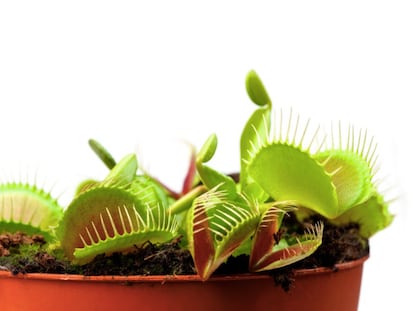Scientists discover one-centimeter long bacterium that’s visible to the naked eye
The organism, identified by a Mexican scientist in a Caribbean mangrove, challenges the very definition of what a microbe is
An international team of scientists has discovered a bacterium measuring nearly one centimeter in length in a mangrove on the French island of Guadeloupe in the Caribbean. The extraordinary organism is visible to the naked eye, meaning it contradicts the very definition of a microbe, which is defined by its microscopic size. The bacterium, which has been named Thiomargarita magnifica, was identified by Mexican microbiologist Silvina González Rizzo, from the University of the French Antilles, in the Guadeloupean city of Pointe-à-Pitre.
The average size of most bacterial species is around two micrometers (μm) – a unit of length equal to 0.001 millimeters or 0.000039 inches. There are, however, some exceptions, such as Thiomargarita namibiensis, which was identified in Namibia in 1999 and measures around 1800 μm. But it is still dwarfed by Thiomargarita magnifica, which has an average cell length of 9,000 μm – the equivalent to nearly centimeter. This makes it 50 times bigger than the bacteria that were considered gigantic up until now, according to the researchers who have released their provisional results in an article that still needs to be peer reviewed. The largest specimen of Thiomargarita magnifica found so far is nearly two centimeters in length.
Microbiologist Silvia G. Acinas, a researcher at Spain’s marine research center Institut de Ciències del Mar, describes it as an “incredible discovery” as it “upsets various paradigms in biology.” Living beings are traditionally divided into two categories: prokaryotes, such as bacteria, and eukaryotes, such as humans. The main difference is that eukaryotes are formed by cells that contain their DNA in a separate nucleus, which is surrounded by a membrane. Bacteria, in contrast, do not have a membrane-bound nucleus and DNA floats freely in the cytoplasm. What’s surprising about Thiomargarita magnifica – aside from its size – is that it contains a structure that is similar to a nuclear membrane, according to Acinas, who did not take part in the research.
The bacterium is of a staggering scale. It contains nearly 12,000 genes, triple the normal amount, and carries nearly half a million copies of this genome, which is an “unprecedented” number according to the researchers. For Acinas, who has co-authored many studies on the discovery of new microbial species, Thiomargarita magnifica is “a marvelous example” to investigate the evolutionary mechanisms that have led this bacterium to be the way it is in an ecosystem as particular as a mangrove.
At least 600 million years ago, life on Earth went from being simple, single-celled organisms to multicellular organisms which then evolved into species as complex as human beings, who are made up of 30 trillion perfectly coordinated cells. The research team led by Silvina González Rizzo says that “the origin of biological complexity is one of the most important, unanswered questions in biology.” The discovery of Thiomargarita magnifica has sparked many responses in the scientific community. Japanese biologist Kazuhiro Takemoto, from Kyushu Institute of Technology, suggested in Science magazine that the new bacterium could even be “a missing link in the evolution of complex cells.”
Spanish biologist Iñaki Ruiz Trillo, from Barcelona’s Institute of Evolutionary Biology, is more cautious. “It’s not a missing link,” he says. “It’s not an intermediary thing between prokaryotes and eukaryotes. Nor is it an intermediary between single-celled and multi-celled organisms. It’s nothing intermediate because it’s not in an intermediate area of the tree of life. It’s a line that has evolved, they have discovered it now and it’s fascinating, but that’s it.”
The discovery of ‘Thiomargarita magnifica’ suggests that bigger and more complex bacteria could be hiding in plain sightAuthors of paper on bacterium‘s discovery
Ruiz Trillo believes that the bacterium’s membrane-like structure could be the result of convergent evolution, when similar features evolve independently such as the wings of a butterfly and the wings of a bat. “This bacteria has become larger, because it has worked well ecologically, and by increasing in size, it has evolved certain characteristics such as compartmentalization, which, for whatever reason, works better for them,” he explains. But while the biologist does not believe it is a missing link, he does admit that “it’s incredible for a bacterial cell to be so big. It breaks every paradigm.”
The story of the discovery of Thiomargarita magnifica dates back a decade. That was when marine biologist Olivier Gros, from the University of the French Antilles, first discovered microbial filaments on leaves buried in the mangrove of Guadeloupe. But five years passed before his colleague González Rizzo identified that these filaments were in fact one bacterium. She herself was the one to choose the scientific name Thiomargarita magnifica, which means “sulfur pearl,” an allusion to the microscopic sulfur granules contained in the bacterium. The preprint analysis of the discovery, however, was only released last month. This analysis was led by biologist Jean-Marie Volland, from the Laboratory for Research in Complex Systems in the United States.
The authors of the provisional article believe the reason why more large bacteria have not been found is due to confirmation bias: the tendency to look for results that confirm a person’s personal beliefs. No one was looking for a bacterium visible to the naked eye. “The discovery of Thiomargarita magnifica suggests that bigger and more complex bacteria could be hiding in plain sight,” they conclude.
Tu suscripción se está usando en otro dispositivo
¿Quieres añadir otro usuario a tu suscripción?
Si continúas leyendo en este dispositivo, no se podrá leer en el otro.
FlechaTu suscripción se está usando en otro dispositivo y solo puedes acceder a EL PAÍS desde un dispositivo a la vez.
Si quieres compartir tu cuenta, cambia tu suscripción a la modalidad Premium, así podrás añadir otro usuario. Cada uno accederá con su propia cuenta de email, lo que os permitirá personalizar vuestra experiencia en EL PAÍS.
¿Tienes una suscripción de empresa? Accede aquí para contratar más cuentas.
En el caso de no saber quién está usando tu cuenta, te recomendamos cambiar tu contraseña aquí.
Si decides continuar compartiendo tu cuenta, este mensaje se mostrará en tu dispositivo y en el de la otra persona que está usando tu cuenta de forma indefinida, afectando a tu experiencia de lectura. Puedes consultar aquí los términos y condiciones de la suscripción digital.











































